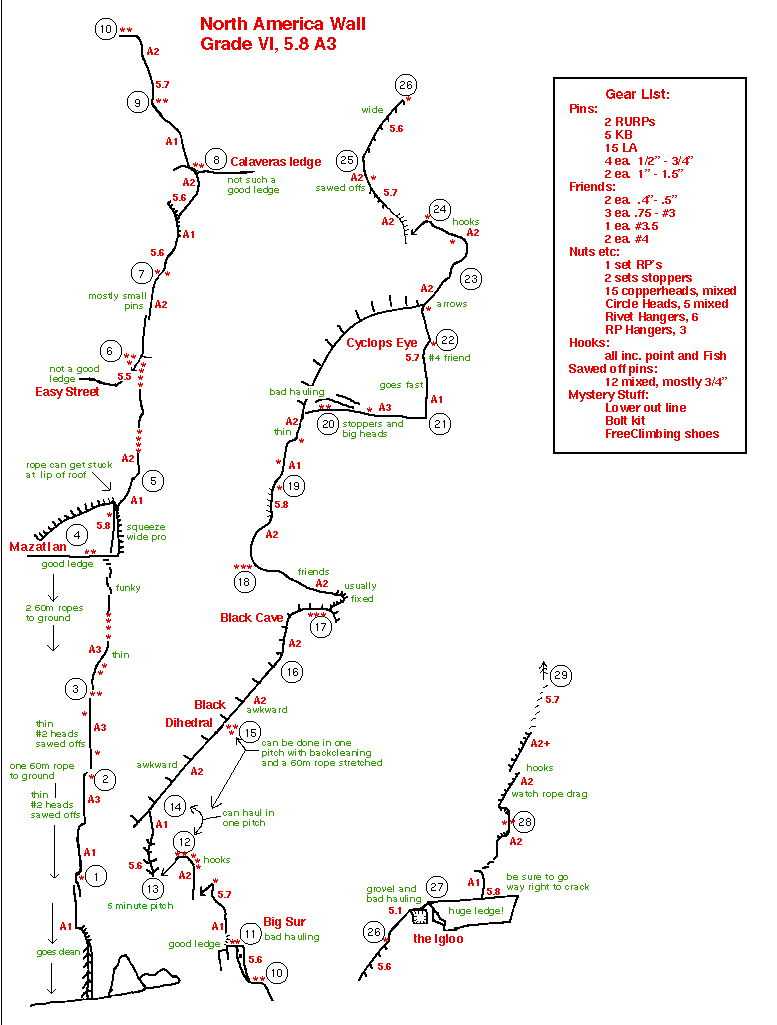
Notes on the route:
The "NA" as it is called, is one of the first real nailing
walls. At the time of the first ascent it was easily the most
technical and demanding wall in all of Yosemite, if not the world.
Frost, Robbins and Chouinard were the big guns of the day, and
this route was their canvas. A great story on the route is found
in The Vertical World of Yosemite and is a must read
before going up on the "NA". Enough with the waxing,
lets get on to the route:
Pitches #1-#4 are the technical crux. Bring all the thin stuff and a handful of heads. Watch out for the "blasted" pin scars, as these will send you back to the "deli" unless you have some sawed off pins. Pitches 2 and 3 catch some runoff in the winter and it is not uncommon for the fixed heads to fall out if you breathe on them. Be careful.
Pitch 5 is the chimney off Mazatlan ledge. It is fairly easy to free without a big wall rack, but the fall is not so good. Use some large pro if this is worrisome. Pitch 6 takes some rivet hangers and goes clean, with a good penji over to the belay. If 5.5 is a problem, bring climbing shoes.
Pitch 11 will take you to Big Sur, a fine ledge and bivy site. The hauling onto this ledge can be grim, so be forewarned and try to set a high hauling anchor if possible. Pitch 13 used to be called "The Rubberband Man" pendulum and takes about 5 minutes for the pitch. Once you get over to the end of the penji, there is a big loose block just above the belay (maybe?) This should not be touched. The next two pitches can be run together if you have a 60m rope and do a lot of backcleaning. The regular anchor for pitch 14 has no bolts and is a stop where you can affair.
The Black Cave bivy is grand. At one time it was called "the most exposed bivy in North America". So be it, for it is pretty keen. The next pitch is "the most exposed pitch in North America" so take a deep breath before sinking the bomber Friends and nuts. Pitch 20 rolls into the base of the Cyclops Eye and is totally jacked. When I did the route, the anchors were nil, and we had to tie up about 70 feet of zip line to get something to haul off of. Word is it still sucks. There is also a bunch of rope drag to make the hauling even worse. Pitch 21 is the big sideways job that is somewhat loose and fixed. There is an odd assortment of gear punched into this crack and historians will love it.
The "Igloo" is nice dank hole that is a good bivy in a storm... until it fills with water. Numerous hard men have been pulled from this bathtub blubbering and hypothermic. If a storm is near, find another bivy site. The top of the Igloo block is a great big platform with plenty of room to roam and has a hideous haul onto it.
Getting onto the summit has always been a challenge on the NA. I got lost, others have gotten lost, and more will follow. The new advice is to move far to the right on the Igloo block and find an "obvious belay". From here work up some free moves and then some easy nailing that leads out and right. The belay is two bolts just below a small right facing corner system. This leads up and right, sometimes wandering, to some 5.7 slab stuff to the summit.
Info provided by: Russ Walling, Steve Ross, Greg Byrne and
others. 